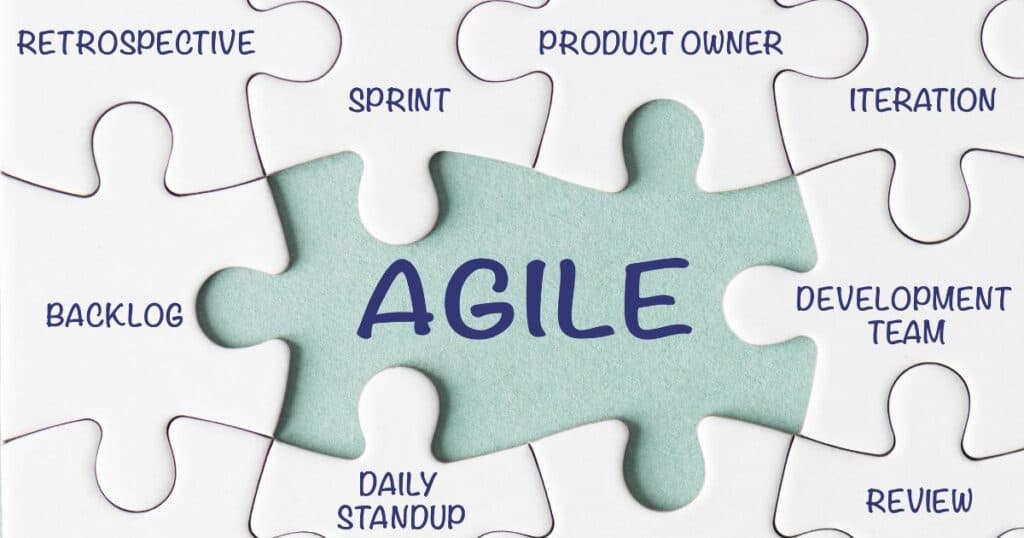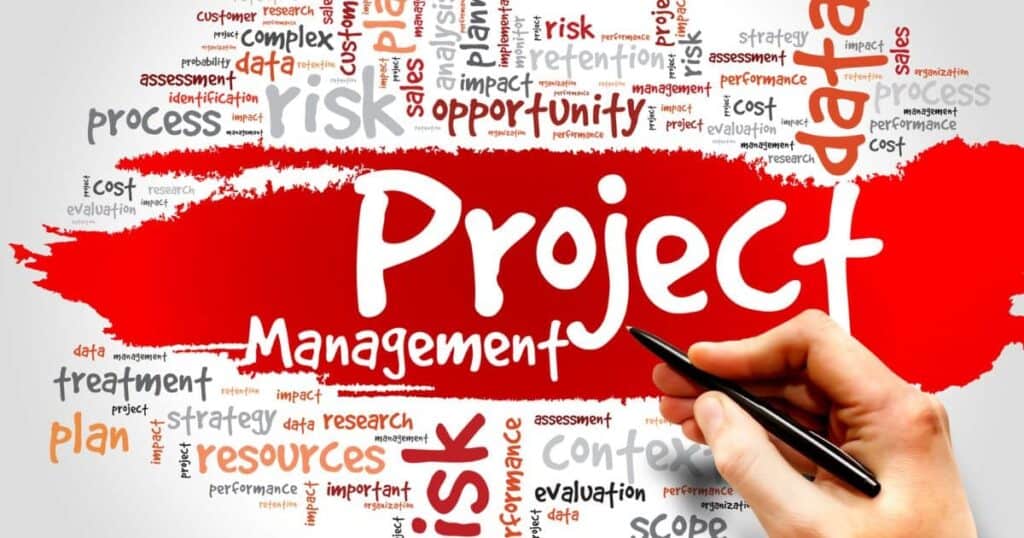If you are looking for a way to stay organized and manage your projects more effectively, then you should consider using an agile project management tool. These tools can help you track your progress and keep your entire team on track.
There are many agile project management tools available, and deciding which is right for you can be hard. That’s why we have compiled a list of 15 of the best agile project management tools out there! Keep reading to find the perfect fit for your team.
Table of Contents
What is Agile?

Agile is a methodology that promotes adaptability and flexibility in project management. It focuses on delivering small chunks of a project, or “sprints,” regularly and quickly. This allows for changes to be made along the way and for the project to evolve as needed.
What is an Agile Project Management Tool?
Before diving into our list of the top 15 tools, it’s important to understand what an agile project management tool is and how it can benefit your team.
Agile project management is a methodology that focuses on adaptability and flexibility, as opposed to rigid processes and strict plans.
The agile approach differs from traditional project management in its emphasis on constant communication and collaboration between team members.
Agile project management software options help facilitate this by providing a platform for organizing tasks, assigning responsibilities, and tracking progress. These tools often have features such as Kanban boards, sprint planning, and team communication channels.
Why are Companies Going Agile?
Many companies are making the switch to agile because of its proven success in helping teams work more efficiently and effectively. Agile project management tools can help companies stay organized and on track, leading to increased productivity and better project outcomes.
Additionally, the agile methodology allows for flexibility in project plans, helping cross-functional teams adapt to changes and pivot when necessary. This can lead to a more successful final product and better team morale.
Now, on to the list of the top 15 best agile project management tools to help you stay organized!
Top Tools: Agile Project Management
Here is a look at the top agile product management tools in the market today:
1. Asana
Asana is a popular and user-friendly project management tool for managing tasks and projects within teams. It offers features like Kanban boards, sprint planning, and project templates.
One standout feature is its customizable dashboards, which allow users to easily track their progress. Drawbacks include its limited integrations with other tools and its lack of a time-tracking feature.
Asana is a popular choice for teams of all sizes, offering features such as Kanban boards, project templates, and task dependencies. It also integrates with other tools like Slack and Google Drive.
One downside is that it can be difficult to switch between different projects on the platform. It also lacks some advanced project management features such as time-tracking and reporting.
Pros
- User-friendly
- Customizable dashboards
- Integrations with other apps
Cons
- Limited integrations
- No time-tracking feature
- Lacks advanced project management features
2. Click-Up
Click-Up is a newer tool that has quickly become a favorite among agile teams. It offers multiple views for organizing tasks, including Kanban boards, Gantt charts, goal tracking, and team management and collaboration.
It also has robust collaboration features, such as adding comments, assigning tasks, and setting reminders. However, it has limited integrations with other tools and can sometimes be difficult to navigate. This tool is best for teams that are more tech-savvy and want a tool with advanced features.
It is a robust Agile project management tool with an intuitive user interface and a wealth of customizable features to boost productivity everywhere. This is irrespective of whether you’re managing releases, bug tracking, creating custom workflows, or wikis.
Pros
- Multiple views for organizing tasks
- Robust collaboration features
- Clean interface
Cons
- Limited integrations
- Difficult to navigate
3. Trello

Trello is a simple and user-friendly tool for managing tasks and projects with a visual approach. It uses Kanban boards to organize tasks and offers features such as checklists, due dates, and team collaboration.
It also allows integrations with other tools like Google Drive and Slack. However, it lacks advanced project management features such as time-tracking and Gantt charts. This tool is best for teams that want a basic and straightforward solution for task management.
Pros
- User-friendly
- Takes a visual approach
- Strong collaboration features
- Allows integrations with other apps
Cons
- Lacks advanced project management features
- Limited reporting capabilities
4. Smartsheet
Smartsheet is a popular tool for managing projects and tasks with a focus on collaboration and real-time communication. It offers features such as customizable dashboards, Gantt charts, and team collaboration.
It also has robust integrations with other tools such as Salesforce and Microsoft Office. One downside is that it can be difficult to navigate and lacks some advanced project management features, such as sprint planning.
Smartsheet takes into account a variety of business solutions, roles, and industries. It consolidates cross-functional priority areas, enables unrestricted team creation, and has open and free collaboration.
Pros
- Collaboration focus
- Customizable dashboards
- Allows integrations with other apps
Cons
- Difficult to navigate
- Lacks advanced project management features
5. Wrike
Wrike is a comprehensive tool for managing projects and tasks, with features such as Gantt charts, resource management, and team collaboration. It also offers customizable dashboards and robust reporting capabilities.
It can, however, be difficult to navigate and has limited integrations with other tools. This tool is best for larger teams that need a comprehensive solution for managing projects and resources.
Wrike is great for linking and centralizing various projects while increasing team productivity. Although it receives a lot of criticism for having a utilitarian interface, trying to set up your project tasks is simple.
Pros
- Comprehensive features
- Customizable dashboards
- Robust reporting for project managers
Cons
- Difficult to navigate
- Limited integrations
6. Monday.com

Monday.com is a visually-focused tool for managing projects and tasks, with features such as Kanban boards, Gantt charts, team collaboration, and integrations with other tools like Slack and Google Drive. It also offers customizable dashboards and real-time updates.
One downside is that it can be expensive for larger teams and lacks some advanced project management features, such as resource management.
Pros
- Visually-focused
- Customizable dashboards
- Allows integrations such as Slack integration
Cons
- Expensive for larger teams
- Lacks advanced project management features.
7. Basecamp
In the Scrum community, Basecamp is a well-liked agile project management tool. The tool is made to function as a team collaboration tool and also a project management tool. On desktop computers and mobile phones, the software solution is simple to use.
Basecamp gives you a central location to encourage effective teamwork, straightforward task management, task reporting, easy file sharing, and real-time in-team communication.
This is a simple tool for managing tasks and projects, with features such as to-do lists, team messaging, and file storage. It offers a straightforward approach and is easy to use. However, it lacks some advanced project management features such as Gantt charts and resource management.
This tool is best for small teams that want a basic solution for task management.
Pros
- Simple, easy to use
- Great for team collaboration
Cons
- Lacks advanced project management features
- Limited reporting capabilities
8. Jira

Jira is a comprehensive tool for managing tasks and projects, with features such as agile project management, team collaboration, and customizable dashboards. It also offers robust reporting capabilities and integrations with other tools like Confluence and Salesforce.
Some of the key features include capturing, assigning, and setting priorities to do work. With Jira, teams get visibility into long-term goals and real-time release information. The dashboard on JIRA can be customized to match your business processes.
One downside is that it can be difficult to navigate and has a steep learning curve for new users. This tool is best for larger teams that need a comprehensive solution for managing projects and tracking progress.
Pros
- Comprehensive features
- Customizable dashboards
- Robust reporting and integrations
Cons
- Difficult to navigate
- Has a steep learning curve for new users
9. Lean Kit
Lean Kit is a Kanban-focused tool for managing tasks and projects, with features like visual management boards, team collaboration, and integrations with other tools like Jira and Salesforce. It also offers customizable action card templates and real-time updates.
One downside is that it lacks some advanced project management features such as Gantt charts and resource management. This tool is best for teams that want a Kanban-focused solution for managing projects and simple team workflow.
This tool’s focus on Lean methodologies – including value stream mapping – makes it a good choice for teams looking to implement and adhere to Lean principles. It also offers a 30-day free trial period and pricing options for teams of all sizes.
Pros
- Customizable Kanban boards
- Focus on Lean principles
- Integrations with popular high-quality software
Cons
- Limited customization options for task management
- Additional fees for some features and integrations
10. Notion
Notion is a versatile tool for managing tasks and projects, with features such as to-do lists, Kanban boards, and team collaboration. It also offers customizable dashboards and integrations with tools like Google Drive and Slack.
Notion provides customizable project action templates, integrations with popular software, and real-time collaboration capabilities. It also offers a free version for personal use and has pricing options for teams and businesses.
This tool’s user-friendly interface and flexibility for different project types make it a popular choice for agile teams. Its robust reporting and analytics feature also provides single-team visibility and insights into project progress.
One downside is that it lacks advanced project management features such as Gantt charts and resource management. This tool is best for smaller teams that want a versatile solution for managing tasks and projects.
Pros
- Customizable project templates and dashboards
- Allows integrations with other software
- Versatile tool
- Real-time collaboration
- Reporting and analytics
Cons
- Limited customization options for task management
- Lacks advanced project management features
12. Active Collab
Active Collab is a comprehensive tool for agile project management, offering customizable workflows, task management features, time tracking, and invoicing capabilities. It also offers a useful blog feature for team communication.
One key advantage of this tool is its integration with popular software such as Slack, Google Drive, and Harvest. It also offers pricing options for teams of all sizes, including a free version with limited features.
Pros
- Customizable workflows
- Allows integrations with popular software
- Blog feature for communication
Cons
- Limited reporting and analytics capabilities
13. GitHub

GitHub is a popular tool for software development teams, offering project management features such as Kanban boards, visual boards, issue tracking, and team collaboration. It also offers integrations with popular tools such as Slack and Jira.
This tool is particularly useful for teams that use GitHub for source code management and want an integrated solution for project management. However, it may not be as comprehensive for non-software development teams or those without experience using GitHub.
Pros
- Integrations with popular tools
- Useful for software development teams
Cons
- It may not be as comprehensive for non-software development teams
- There is a learning curve for those unfamiliar with GitHub
14. Kanbanize
Kanbanize offers a comprehensive tool for agile project management, with features such as customizable Kanban boards, real-time collaboration, and reporting and analytics. It also offers integrations with popular software such as Jira and Slack.
This tool’s focus on Kanban principles and customizable boards make it a good choice for teams looking to implement and adhere to Kanban project management methodologies. It also offers a free trial period and pricing options for teams of all sizes.
Pros
- Customizable Kanban boards
- Integrations with popular software
- Focus on Kanban principles
Cons
- Limited customization options for task management
- Additional fees for some features and integrations
15. Axosoft
Axosoft offers project management features such as customizable Kanban boards, sprint planning, and issue tracking. It also offers integrations with popular software such as Jira and Slack, as well as a built-in Help Desk feature for customer support teams.
This tool’s customizable Kanban boards and sprint planning make it a good choice for agile teams. It offers a free version for small teams and pricing options for larger teams.
Pros
- Customizable Kanban boards
- Sprint planning
- Integrations with popular software
- Help Desk feature
Cons
- Limited reporting and analytics capabilities
- Additional fees for some features and integrations
What to Look for in an Agile Project Management Tool

Here are factors to consider when choosing an agile project management tool:
Ease of Use
The tool must be easy to navigate and understand for all team members. Otherwise, adoption may be slow, and there may be confusion about how to use certain features.
Look for a tool with a user-friendly interface and helpful tutorials or resources for onboarding new team members.
Integrations with Other Tools
Look for a tool that can easily integrate with other software your team may already be using. This will streamline your agile workflows and eliminate the need for multiple platforms or tools.
Popular software to look for integrations includes project planning and team communication tools, as well as file-sharing services.
Real-Time Collaboration Capabilities
In agile project management, team members need to be able to collaborate and communicate in real time.
Look for a tool that offers features such as group chat, task assignment and commenting, and project brainstorming. This will ensure that team members are always on the same page and can quickly address any issues that arise.
Customizable Project Templates
Look for a tool that allows you to customize project templates to fit your specific needs. This will save time and make it easier to plan future projects, as well as ensure that all necessary steps and tasks are included.
When it comes to customizing project templates, also look for the ability to add and track specific metrics that are important to your team’s success.
Flexibility for Different Project Types
It’s important to choose a tool that can accommodate the specific needs of your team and the types of projects you typically work on. Look for a tool that offers flexibility in terms of project structure, task management, and collaboration options.
Flexibility is an especially important factor for teams that work on a mix of different project types or may need to adjust their process as the project progresses.
Reporting and Analytics Capabilities
When it comes to agile project management, it’s important to have clear visibility into the progress and success of your team.
Look for a tool that offers reporting and analytics capabilities, such as graphs and charts to track project progress, task completion rates, and team performance. This will help with goal setting and identifying areas for improvement.
Pricing Options
Look for an agile project tool that offers pricing options that fit your team’s budget and needs. Many tools offer different tiers of pricing, with varying features and limitations based on the number of users or projects. Some may also offer a free version with limited features, or a free trial period.
Consider the agile project cost in relation to the benefits and features it offers for your team. It may be worth investing in a more expensive, comprehensive tool if it will greatly improve your team’s productivity and overall success. However, a less expensive option with the necessary features may also work well for your team.
Why Do Teams Need Agile Tools?
Agile project management tools can be highly beneficial for teams for several reasons. These include:
Facilitate Communication Among Team Members
Agile tools often offer features such as group chat and task assignment, allowing for seamless communication and collaboration. This ensures everyone is always on the same page and able to quickly address any issues that arise.
Increase Productivity and Efficiency
Agile collaborative tools offer a clear, organized structure for managing tasks and projects. This helps teams stay on track and reach their goals on time.
Provide Visibility into Project Progress
Agile tools often offer reporting and analytics capabilities, allowing teams to track their progress and identify areas for improvement. This is done through features such as graphs and charts to track task completion rates and team performance.
Flexibility for Different Project Types
Many agile tools offer customizable project templates and the ability to adjust project structure as needed. This is especially important for teams that work on a variety of different types of projects and may need to adjust their process as the project progresses.
Drawbacks to Using Agile Tools
While agile tools can be extremely helpful for teams, there are also some potential drawbacks to consider when it comes to these agile project management capabilities. These include:
They Require a Learning Curve
Using a new tool can take some time for team members to get accustomed to. This may result in a temporary decrease in productivity as they learn the tool’s features and how to best utilize them for their specific needs.
They May Not Have All the Necessary Features
Not all agile tools offer the same features, so it’s important to carefully consider and compare options to find the best fit for your team’s needs. It may be necessary to use multiple tools to access all necessary features.
They May Not Integrate with Other Platforms
Depending on the tool, it may not integrate with other platforms and software that your team uses. This can make it difficult to streamline processes and may require extra steps for sharing information and completing tasks.
They Require Ongoing Technical Support
As with any technology, technical issues can arise with agile tools. It’s important to make sure the tool you select has reliable technical support for resolving any issues that may come up.
They May Not Fit with Your Team’s Specific Workflow
While agile tools can offer structure and organization, they may not necessarily align with or complement your team’s specific workflow and processes. In this case, it may be more beneficial to stick with a simpler method of project management.
They May Not be Cost-Effective for Smaller Teams
Many agile tools often have pricing plans based on the number of users or projects, which may not make them cost-effective for smaller teams with fewer members or projects.
Tips for Incorporating Agile Tools
When incorporating agile tools into your team’s workflow, it’s important to keep a few things in mind:
- Communicate the benefits and any potential drawbacks to team members so they understand the reasons for using the tool.
- Involve team members in the selection process to ensure the tool will meet their needs and fit with their workflow.
- Provide training to ensure team members are familiar with using the tool effectively.
- Consistently review and reassess the tool’s effectiveness to ensure it is still meeting the team’s needs, and make adjustments as necessary.
- Ensure ongoing technical support is available for any potential issues that may arise with the tool.
- Consider the cost-effectiveness of the tool, especially for smaller teams.
- Have a backup plan in case the tool is not successful or stops meeting the team’s needs. This may include using a different tool or going back to a simpler method of project management.
- Have a designated team member responsible for managing the tool and staying up to date on any updates or changes.
Industries That Can Benefit From Agile Tools

Agile tools can benefit a variety of industries and teams, including:
- Software development: Agile tools can be particularly helpful for managing the often-changing and fast-paced nature of software development projects.
- Marketing and advertising: Agile tools can assist with organizing and managing the various components and tasks involved in marketing campaigns.
- Research and development: Agile tools can be useful for managing the iterative and collaborative processes involved in research and development projects.
- Education: Agile tools can aid with organizing and streamlining the various tasks and responsibilities involved in education, such as lesson planning and managing student projects.
- Healthcare: Agile tools can help healthcare teams stay organized and on track with patient care and other responsibilities.
- Construction: Agile tools can assist with managing the various components and tasks involved in construction projects.
- Design: Agile tools can help design teams and creative agencies stay organized and on track with their projects, from concept to completion.
- Finance: Agile tools can aid with organizing and streamlining the tasks involved in financial planning and management.
- Human resources: Agile tools can assist HR teams with organizing and managing employee information, tasks, and responsibilities.
- Retail and e-commerce: Agile tools can help with organizing and managing the various tasks involved in running a retail or e-commerce business.
Agile tools can help teams stay organized, communicate efficiently, track tasks in progress, and adjust their processes in these industries and others. Ultimately, they can lead to a more successful and streamlined workflow for teams.
Frequently Asked Questions (FAQs)
How do I choose the right agile project management tool for my team?
It’s important to carefully consider and compare options to find the best fit for your team’s needs. This may require involving team members in the selection process, determining the necessary features, and considering any potential drawbacks or cost-effectiveness.
It may also be necessary to use multiple tools to access all necessary features. Ultimately, the tool should align with your team’s specific workflow and processes to be successful.
What if my team is not familiar with agile project management?
Provide training or resources to familiarize team members with agile project management and the specific tool being used. Communicate the benefits of using an agile tool to ensure team buy-in and successful adoption.
Start small by implementing agile methods for one specific project before fully incorporating it into the team’s overall workflow. It’s important to consistently review any potential challenges and make adjustments as necessary. Ultimately, using an agile tool can lead to a more efficient and successful workflow for the team.
Can agile tools be used by individuals or only teams?
Agile tools can be used by individuals, teams, or a combination of both. It’s important to consider the specific needs and workflow of the individual or team to determine the most effective and efficient tool to use.
Some tools may have pricing options that are more suitable for individuals or smaller teams. Ultimately, the tool should align with the individual or team’s specific processes to be successful.
How do agile tools compare to traditional project management methods?
Agile tools can provide more flexibility and the ability to quickly adjust processes as necessary. They can also help with efficient communication and collaboration, tracking progress, and staying organized.
Traditional project management methods may involve more rigid processes and require additional resources, such as physical or digital project management templates.
Ultimately, it’s important to carefully consider the specific needs and workflow of the individual or team to determine which method will be most successful. This may involve using a combination of both agile and traditional methods.
How often should my team review and adjust our use of agile project management tools?
It’s important to consistently review and assess the effectiveness of the agile tool in alignment with your team’s specific workflow and processes. This may involve regular check-ins or meetings to discuss any challenges and make adjustments as necessary.
It may also be helpful to gather customer feedback from team members on their experience using the tool and if any changes or improvements should be made. The tool should consistently support and improve the team’s overall workflow to be successful.
Can agile project management tools be used for any type of project?
While agile tools can be used for various types of projects, it’s important to carefully consider if the tool aligns with the specific needs and workflow of the project. Agile methods may not be suitable for all projects, such as those with rigid processes or specific templates that need to be followed.
It may also be necessary to use multiple tools to access all necessary features for the specific project. Make sure to carefully assess the project’s needs and determine if agile methods will be successful before fully incorporating them.
How can agile project management techniques support team communication and collaboration?
Agile project management techniques, such as regular check-ins and progress updates, can support communication and collaboration by providing a space for team members to share their progress and any challenges they may be facing.
These techniques also emphasize the importance of adaptability and continuous improvement, which can support the team in finding effective solutions to challenges and improving communication and collaboration as needed. Additionally, using agile project management tools that offer communication and collaboration features can also support team communication and collaboration throughout the project’s lifecycle.
What are some common features of agile project management tools?
Some common features of agile project management tools include task tracking, progress tracking, communication and collaboration platforms, reporting, and agile methodology support (such as Scrum teams and Kanban boards).
It’s important to carefully consider the specific needs of the team or project to determine which features will be most useful and effective. Some tools may also offer additional features, such as resource management and integrations with other software.
What are the five Agile project management model phases?
The five phases of the agile project management model are planning, development, release, feedback, and adaptation.
The planning phase involves setting the project goals and creating a roadmap for completion.
The development phase implements the actionable plan by assigning tasks and completing them. In the release phase, the completed project is presented and delivered. The feedback phase involves gathering feedback from clients or stakeholders to assess the project’s success and gather ideas for improvement.
Finally, the adaptation phase implements changes and adjustments based on the feedback received. This model emphasizes agility and continuous improvement throughout the project’s lifecycle.
How can agile project management tools support the agile project management model?
Agile tools can support the agile project management model by providing features such as task tracking, progress reporting, communication and collaboration platforms, and agile methodology support. This can assist with efficiently implementing the model’s phases, such as automatic planning and adapting based on feedback.
Carefully assess the specific needs of the project to determine which agile tool features will be most effective in supporting the agile model. The tool should also be consistently reviewed and adjusted as necessary for it to effectively support the agile model and project success.
What are the key components of project management?
The key components of project management include setting and defining goals, creating a plan for achieving those goals, organizing and assigning tasks, monitoring progress and making adjustments as necessary, and successfully delivering the completed project.
Effective project management can help ensure the successful completion of a project within the designated timeframe and budget. It also involves communication and collaboration with team members and stakeholders, as well as risk management and adaptation to any potential challenges that may arise.
How can agile project management techniques support a company’s success?
Agile project management solutions can support a company’s success by promoting effective goal-setting, planning, and execution. This can result in the successful completion of projects within the designated timeframe and budget.
The emphasis on adaptability and continuous improvement can also benefit a company by ensuring it can adapt to changing circumstances and constantly improve its processes. In addition, using agile techniques can support a company’s overall productivity and efficiency, leading to a more successful business.
What are some common challenges in agile project management?
Some common challenges in agile project management include resistance to change, difficulty effectively prioritizing tasks, lack of clear communication and collaboration processes, and difficulties in measuring success.
Resistance to change can be overcome by presenting the benefits of agile techniques and providing proper training and support. Prioritization can be improved by involving stakeholders in setting project priorities and regularly reassessing and adjusting them as necessary.
Clear communication processes can be established through regular meetings and assigning roles and responsibilities. Measuring success can be improved by setting specific, measurable goals and regularly assessing progress toward those goals.
Conclusion
In summary, agile project management tools can play a crucial role in supporting a company’s success through promoting effective goal-setting, planning, and execution, adaptability, and continuous improvement.
It is important to carefully assess the specific needs of a project to determine which agile management tool features will be most effective. Overall, using agile techniques can support a company’s productivity and success.

I’m a blogger and entrepreneur. I want to help you in your journey to build your business online.


